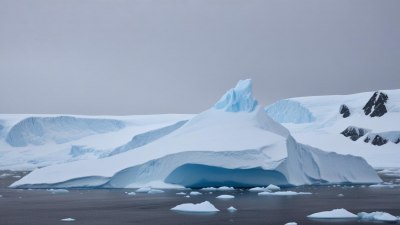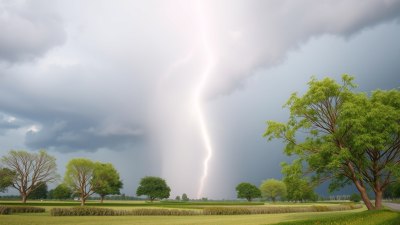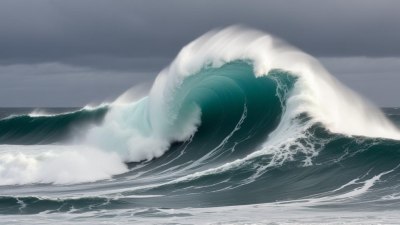What Antarctica’s Ice Can Tell Us About Weather Before Humans Even Existed
Discover insights from Antarctica's ice cores about ancient weather patterns before human influence.

This image was created with the assistance of Freepik
Antarctica, often regarded as a barren wasteland, is in fact a treasure trove of climate history. The vast ice sheets that cover this desolate land hold clues about the Earth’s climate long before the advent of human civilization. Through the study of ice cores, scientists can reconstruct past climates, understand natural variability, and gain insight into the mechanisms governing Earth's weather. This article delves into how Antarctica's ice can reveal weather patterns from millions of years ago, enhancing our understanding of climate change and its implications.
The Formation of Antarctic Ice
The ice of Antarctica is not uniform; it has accumulated over millions of years. As snow falls in the region, it compresses over time into dense ice layers. These layers trap air bubbles that provide ancient samples of the atmosphere. Each layer corresponds to a specific time period, allowing scientists to analyze changes in greenhouse gas concentrations, temperature, and even precipitation rates. Through a detailed study of these layers, researchers can uncover records of Earth's climate dating as far back as 800,000 years.
Understanding Ice Cores
Ice core samples are extracted using specialized drills that can reach depths of several kilometers. The data extracted from these cores allow scientists to chart variations in temperature and atmospheric composition over millennia. Each core essentially acts like a time capsule, offering snapshots of the Earth’s climatic conditions at different points in history. The isotopes contained within the ice give insights into temperature variations, while the layers themselves reveal changes in snowfall and other atmospheric conditions.
The History Embedded in Layers
One of the most significant findings from Antarctic ice cores is the record of glacial and interglacial periods. Throughout Earth's history, there have been cycles of ice ages, characterized by colder temperatures and expanding ice sheets, followed by warmer periods that saw the retreat of glaciers. The analysis of these cycles provides critical context for present climate debates, highlighting how Earth's climate system functions naturally over long timescales.
Greenhouse Gases Across the Ages
Through the analysis of trapped gas bubbles in ice cores, scientists have discovered that levels of carbon dioxide and methane have varied considerably. Before the Industrial Revolution, carbon dioxide levels fluctuated between 180 and 300 parts per million (ppm) during glacial and interglacial periods. In stark contrast, current levels surpass 400 ppm, showcasing the profound impact human activity has had on atmospheric composition. By studying the historical data on greenhouse gases, we gain essential insights into the relationship between carbon dioxide concentrations and temperature changes, underscoring the critical role these gases play in our climate system.
Lessons from the Past Climate Change
The historical climate data gathered from Antarctic ice has relevance not just for understanding natural fluctuations, but also for contextualizing today’s climate crisis. By elucidating the mechanisms that drove past climate changes, researchers can improve climate models that predict future scenarios. For example, past records show how rapid warming events occurred in response to natural factors like orbital changes and volcanic eruptions, but the current rate of change due to human activity is unprecedented.
Finding Analogies to Modern Climate Trends
By comparing today’s climate change with past events recorded in ice cores, scientists can draw important parallels. For instance, during the Pleistocene epoch, rapid warming periods drastically altered ecosystems and led to significant shifts in biodiversity. Such historical precedents illustrate that the world has undergone transformative climate changes, raising questions about current trends and potential consequences. Understanding these past events equips us with a clearer picture of potential futures under continued anthropogenic influence.
The Role of Ocean Currents
Antarctica's ice also reveals insights about ocean currents, which play a crucial role in global climate. Ocean currents act as large conveyor belts, transporting warm and cold water around the planet, thereby influencing weather patterns. Ice core data can help reconstruct how ocean currents have changed over thousands of years, offering clues about related alterations in global weather systems. For instance, ices cores provide evidence of the North Atlantic thermohaline circulation, which is directly affected by melting ice in the polar regions.
Environmental Impacts of Ice Melt
The effects of a warming climate are already evident in Antarctica, with significant ice melt occurring in recent decades. The Antarctic Peninsula, in particular, has seen some of the fastest warming rates on the planet. The ice melt contributes to global sea-level rise, which poses a threat to coastal communities worldwide. Analysis of ice cores aids in predicting potential future melting patterns based on historical data, providing valuable insights for policymakers tackling climate change and its associated impacts.
Collaborative Global Efforts
Research in Antarctica is a collaborative effort involving scientists from various countries, each bringing their unique expertise to understand this crucial component of the Earth’s climate system. International partnerships enhance the scope and scope of research, allowing for better data collection and comprehensive modeling efforts. Such collaboration is vital in combating climate change, promoting global understanding of the issue, and fostering solutions to mitigate future impacts.
Public Engagement and Education
Understanding the climatic history embedded in Antarctica’s ice is not only vital for scientists but also for the general public. Increased awareness about past weather patterns empowers individuals to take action against climate change. Educational initiatives that bring attention to the insights gained from Antarctic ice can inspire the next generation of climate scientists and advocates. Informing the public about the significance of climate history enables a more informed and proactive approach to addressing current challenges.
Future Directions in Research
Research on Antarctic ice will continue to evolve as technology improves and our understanding of climate change deepens. Future studies may explore areas currently inaccessible or use advanced techniques to analyze the ice with greater precision. This ongoing work is crucial for improving climate models and predictions and enhancing our overall comprehension of Earth's climate system. Antarctica holds records that can inform global climate strategies, making it more critical than ever to focus on this unique and fragile environment.
The insights gleaned from Antarctica's ice tell a compelling story about Earth’s climate long before human existence. As we navigate the impacts of our current climate crisis, the data collected from these ice cores serves as a vital reminder of our planet’s dynamic history. By learning from the past, we can better understand the present and future, allowing us a chance to make meaningful changes for our environment. Antarctica's ice is not just frozen water; it is a record of Earth's evolving climate, offering essential lessons for generations to come.











